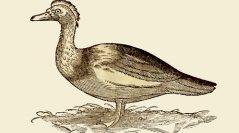

 Anthropozoologica
54 (13) - Pages 123-139
Anthropozoologica
54 (13) - Pages 123-139Now a global inhabitant, the Muscovy duck Cairina moschata (Linnaeus, 1758) was domesticated millennia ago by Pre-Columbian indigenous societies of America. Driven increasingly afar by humankind, the expansion of this species is an example of the successful dispersion of an animal known for its adaptability and resilience. This article examines various cases of husbandry, reproduction, and uses of Cairina moschata in the north and central coasts of Perú, Mexico, and North America. This exercise permits us to identify the various ways in which humans approach this versatile, charismatic, and always independent bird raised for its meat, unique behavior, or quality as companion animal or pet. As a hybrid animal, the Muscovies can also withstand extreme food conditions aimed to transform the mestizo duck in special human food. Cairina moschata ducks are a sign of belonging, tradition, innovation, and economy in Perú, Mexico, the United States, and digital communities. This analysis, in addition to allowing us to identify patterns, distinctions, and paths to new forms of human-animal relationships, permits us to explore a broader approach to the construction of the ontological nature and agency of an animal whose existence appears interwoven with our own.
Multispecies ethnologies, ontology, ducks, human-animal relationship, breeding, captivity.